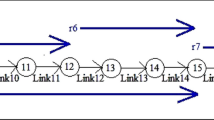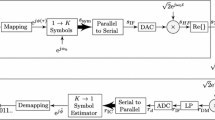Abstract
Currently, wireless communications are changing along the lines of three main thrusts. The first is the introduction of secondary spectrum licensing (SSL). Regulations on the usage of licensed spectra are being loosened, encouraging unused primary spectrum to be licensed, often in an opportunistic manner, to secondary devices. The second is the introduction of cognitive radios. These wireless devices are able to sense and adapt in a “smart” manner to their wireless environment, making them prime candidates to becoming secondary users in SSL initiatives. Finally, as we approach the communication limits of point-to-point channels, and as wireless devices become cheap and ubiquitous, the focus is shifting from single to multiple communication links, or networks. In this paper, we provide an overview of the recently established theoretical limits, in the form of sum-rates, or throughput, of two main types of networks: ad hoc networks, in which the devices are homogeneous, and cognitive networks, in which a mixture of primary and secondary (or cognitive) devices are present. We summarize and provide intuition on how the throughput of a network scales with its number of nodes n, as n → ∞, under different network and node capability assumptions.
Similar content being viewed by others
References
Agarwal A., Kumar P.R. (2004). Capacity bounds for ad-hoc and hybrid wireless networks. ACM SIGCOMM Computer Communication Review 34(3):71–81
Ahmad A., Jovicic A., Viswanath P. (2006). On outer bounds to the capacity region of wireless networks. IEEE Transactions on Information Theory 52(6):2770–2776
Cover, T. M., & Thomas, J. A. (2006). Elements of Information Theory. John Wiley & Sons.
Devroye N., Mitran P., Tarokh V. (2006). Achievable rates in cognitive radio channels. IEEE Transactions on Information Theory 5(5):1813–1827
Federal Communications Commission Spectrum Policy Task Force FCC Report of the Spectrum Efficiency Working Group. (2002). http://www.fcc.gov/sptf/files/SEWGFinalReport_1.pdf
Franceschetti M., Dousse O., Tse D., Thiran P. (2007). Closing the gap in the capacity of wireless networks via percolation theory. IEEE Transactions on Information Theory 53(3):1009–1018
Gupta P., Kumar P.R. (2000). The capacity of wireless networks. IEEE Transactions on Informations. Theory 46(2):388–404
Jiang, J., & Yan, X. (2007). On the achievable rate regions for interference channels with degraded message sets. IEEE Transactions on Information Theory (submitted).
Jovicic A., Viswanath P., Kulkarni S. (2004). Upper bounds to transport capacity of wireless networks. IEEE Transactions on Information Theory 50(11):2555–2565
Jovicic, A., & Viswanath, P. (2007). Cognitive radio: an information-theoretic perspective. IEEE Transactions on Information Theory (to appear).
Lévêque O., Telatar I. (2005). Information-theoretic upper bounds on the capacity of large extended ad hoc wireless networks. IEEE Transactions on Information Theory 51(3):858–865
Maric, I., Goldsmith, A., Kramer, G., & Shamai, S. (2007). On the capacity of interference channels with a cognitive transmitter. Workshop on Information Theory and Applications (ITA).
Mitola, J. (2000). Cognitive Radio, Ph.D. thesis. Royal Institude of Technology (KTH).
Özgür A., Lévêque O., Preissmann E. (2007). Scaling laws for one and two-dimensional random wireless networks in the low attenuation regime. IEEE Transactions on Information Theory 53(10):3573–3585
Özgür A., Lévêque O., Tse D. (2007). Hierarchical cooperation achieves optimal capacity scaling in ad hoc networks. IEEE Transactions on Information Theory 53(10):3549–3572
Vu, M., Devroye, N., Sharif, M., & Tarokh, V. (2007). Scaling laws of cognitive networks. Invited paper, Proceedings of CrownCom, Aug, 2007.
Vu, M., Devroye, N., & Tarokh, V. (2008). The primary exclusive region in cognitive networks. Invited paper, Proceedings of IEEE Consumer Communication and Networking Conference (CCNC), Jan, 2008.
Wu W., Vishwanath S., Aripostathis A. (2006). Capacity of a class of cognitive radio channels: interference channels with degraded message sets. IEEE Transactions on Information Theory 53(11):4391–4399
Xie L., Kumar P.R. (2004). A network information theory for wireless communication: scaling laws and optimal operation. IEEE Transactions on Information Theory 50(5):748–767
Xie L., Kumar P.R. (2006). On the path-loss attenuation regime for positive cost and linear scaling of transport capacity in wireless networks. IEEE Transactions on Information Theory 52(6):2313–2328
Xue, F., & Kumar, P. R. (2006). Scaling laws for ad hoc wireless networks: an information theoretic approach. NOW Publishers.
Author information
Authors and Affiliations
Corresponding author
Additional information
Portions of Sect. 4 has appeared in Vu et al. 2007 [16].
Rights and permissions
About this article
Cite this article
Vu, M., Devroye, N. & Tarokh, V. An Overview of Scaling Laws in Ad Hoc and Cognitive Radio Networks. Wireless Pers Commun 45, 343–354 (2008). https://doi.org/10.1007/s11277-008-9479-0
Received:
Accepted:
Published:
Issue Date:
DOI: https://doi.org/10.1007/s11277-008-9479-0




